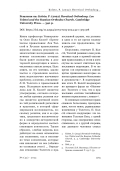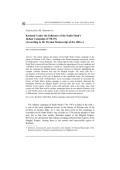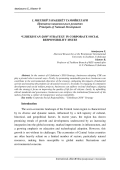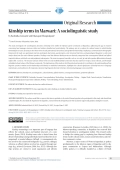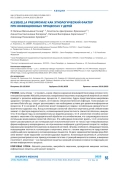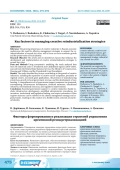Рецензия на: Kolstø, P. (2022) Heretical Orthodoxy. Lev Tolstoi and the Russian Orthodox Church. Cambridge University Press. — 340 p.
The article explores the impact of the Nadir Shah’s Indian campaign on the region of Kashmir in the 18th c., according to the Persian-language manuscript written by Muhammad ‘Azam Didamari. The manuscript provides unique insights into how Nadir Shah’s actions affected Kashmir, including the appointment of a new subahdar and a rebellion of the local population. Contrary to a popular belief, the author suggests that after the campaign the Mughal Empire retained control over Kashmir, highlighting the complex relations between Iran and the Mughal Empire. The study calls for a reevaluation of historical accounts of Nadir Shah’s campaign and emphasizes the need for further research of the role of Kashmir in this significant event. The information presented in the work of Muhammad ‘Azam encourages researchers to reconsider the history of Nadir Shah’s Indian campaign in order to more accurately determine the boundaries between the Mughal Empire and Iran after this event. The mention of Kashmir in the context of these events adds particular value to the study, since other sources on Nadir Shah and his military campaigns either do not mention Kashmir at all or only briefly touch on the region. In this context, the presence of this plot in the work of Muhammad ‘Azam is unique and calls for further research and analysis.
O’zbekistonning 2030 yilgi strategiyasi doirasida KSSNI qabul qilgan korxonalar bir necha jihatdan hal qiluvchi rol o’ynashi mumkin. Birinchidan, barqaror amaliyotni targ’ib qilish orqali korxonalar strategiyaning ekologik maqsadlariga hissa qo’shishi, sanoat faoliyati ta’sirini yumshatishi va tabiiy resurslardan oqilona foydalanishni ta’minlashi mumkin. Ikkinchidan, jamiyatni rivojlantirish va ijtimoiy ta’minot loyihalari bilan shug’ullanish orqali korxonalar strategiyaning barcha fuqarolarning hayot sifatini yaxshilashga qaratilgan yo’nalishiga mos ravishda ijtimoiy muammolarni hal qilishlari mumkin. Va nihoyat, axloqiy me’yorlar va boshqaruvni qo’llab-quvvatlash orqali korxonalar shaffoflik va hisobdorlik madaniyatini rivojlantirib, millatning institutsional asoslarini mustahkamlashlari mumkin.
This study investigates the sociolinguistic functions of kinship terms within the Marwari speech community of Rajasthan, addressing the gap in research concerning how language structures reflect and reinforce familial and social identity. The primary aim is to explore the cultural context in which kinship terminologies are used, focusing on how these terms encode generational, hierarchical, and gendered relationships. Employing a communication ethnographic framework, the study uses participant and non-participant observation, questionnaires, semi-structured interviews, and genealogical diagrams to collect and analyse data from five native Marwari speakers. Findings reveal that Marwari kinship terms are distinctly categorised into consanguineal (blood) and affinal (marital) relations, with both core and peripheral subcategories. The terms incorporate honorifics such as /sa/ and /ɟi/ and reflect gender differentiation through suffixes like /i/ and /ni/. The structure and use of these terms not only establish familial connections but also underscore respect, social cohesion, and the deeply embedded cultural values of the Marwari community. The implications of this study are both theoretical and practical: it contributes to the understanding of how linguistic practices mediate social relationships and identity in traditional communities, highlights the cultural significance of kinship lexicons in language maintenance, and underscores the importance of preserving linguistic diversity in the face of increasing language contact and shift.
Цель обзора — установить, каким образом нарушения взаимодействия между условно-патогенными бактериями Klebsiella pneumoniae, микробиомом кишечника и врожденной иммунной системой приводят к развитию инфекционных процессов. K. pneumoniae, будучи представителем микробиома здорового человека, может служить источником оппортунистической инфекции. Колонизацию кишечника Klebsiella spp. следует рассматривать как необходимое условие для развития инфекционных процессов. В то же время K.>pneumoniae может передаваться людям с ослабленным иммунитетом от практически здоровых лиц. Исход колонизации слизистой оболочки кишечника детей клебсиеллами зависит от факторов вирулентности, колонизационной резистентности слизистой оболочки, иммунитета. В последние годы на экспериментальных моделях доказано, что K. pneumoniae способна колонизировать кишечник и без предварительной обработки его антибиотиками, что сопровождается воспалительными изменениями слизистой оболочки. Эти наблюдения позволяют думать, что K. pneumoniae может рассматриваться как потенциальный этиологический агент не только при генерализованных формах инфекции у новорожденных, но и при кишечных инфекциях у детей раннего возраста с несформированными микробиотой кишечника и иммунной системой. Штаммы клебсиелл, обладающие генами, повышающими плотность колонизации в кишечнике, вместе с генами вирулентности представляют наибольший риск заражения у колонизированных пациентов. На риск заражения бактериями рода Klebsiella влияют также нарушения состояния здоровья пациента. Колонизация кишечника K. pneumoniae должна рассматриваться как пример уклонения патогена от реакций иммунитета хозяина, а иммунные стратегии K. pneumoniae — как преодоление защитных реакций организма хозяина последующим развитием инфекционного процесса.
Relevance The growing importance of creative industries in Russia’s economy underscores the need for effective management strategies to support the reindustrialization of second-tier cities, with a focus on socio-economic growth and the preservation of local identity. Research Objective The article aims to identify key factors that influence the development and implementation of creative reindustrialization strategies in second-tier cities. Data and Methods Using econometric modeling, the study analyzed data from 50 industrial cities in Sverdlovsk and Chelyabinsk regions (2010-2024), sourced from the Federal State Statistics Service, the Ministry of Construction, Housing and Utilities, and the Presidential Grant Foundation. Results. The study identified key factors contributing to the growth of creative industries, including the expansion of creative sector companies, proximity to regional centers, increased grant applications, the presence of manufacturing enterprises, growth in local government revenue, and the development of new housing. A comprehensive set of government support measures was proposed, encompassing infrastructure development, financial assistance, educational initiatives, informational resources, and regulatory improvements. Conclusions Essential government support to creative industries should include infrastructure development, simplified administrative procedures, tax incentives, institutional and legislative backing, and export promotion. Other support measures can be tailored to the chosen management strategy and regional needs, resulting in the creation of a flexible system centered around local identity.
